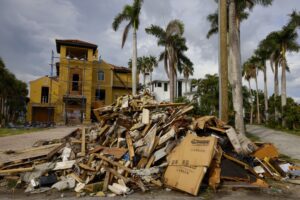- Home
- About
- Insurance
- Quote
- Dental/Health
- Service
- Notary
- News
- Referral Partners
- Agent Resources
Interested in Claims?
Get automatic alerts for this topic.

[ad_1]
Hurricane Ian caused extensive damage in southwest Florida, with more than 37,000 National Flood Insurance Program claims, making it the fourth-most expensive flood disaster in U.S. history, says a new report from the Federal Emergency Management Agency.
As other studies have found, newer and elevated homes in coastal areas fared much better than did those that were not elevated above storm surge and flood levels, notes the report, Hurricane Ian NFIP Claims Analysis, released in December. The average flood claim in 12 areas in and around Fort Myers for elevated structures was $50,287, compared to $158,291 for non-elevated buildings.
In one selected area, DeSoto County, the difference was even greater: The average claim for elevated structures was just over $9,600, compared with a $122,726 average for non-elevated buildings. About 33% of the homes in the study areas were elevated. The flood depth reached up to 9 feet in Fort Myers Beach and almost that depth in San Carlos Bay, near Fort Myers.

The report found that even with elevated homes, though, finished enclosures did not always comply with policy requirements and they contributed to damage.
“Various elements that did not appear to comply with flood-damage-resistant material requirements and had functions beyond the only allowable uses of parking, building access, and storage below the lowest floor, were prevalent,” the study said. “These common issues reduced building and community resilience by generating avoidable flood damage, creating debris that caused the closing and blocking of countless roads, required cleanup and repairs, and unnecessarily tied up limited resources.”
The study indicated that flood insurance coverage in the Lee County area was more prevalent than the state average and was more widespread than had been previously reported. For some 2,800 parcels examined, about 45% had NFIP policies. Previous reports have shown that only about 18% of Floridians carried flood insurance in 2022.
The 91-page FEMA report can be seen here.
Related: Florida Building Codes Made a Big Difference for Newer Homes in Ian
Bills Would Provide Millions in Flood Mitigation, Elevation Grants
Get automatic alerts for this topic.
[ad_2]
Source link
Comment (0)